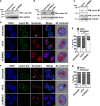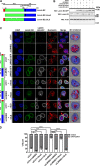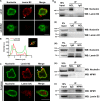Lamin B2 Modulates Nucleolar Morphology, Dynamics, and Function
- PMID: 28993479
- PMCID: PMC5705821
- DOI: 10.1128/MCB.00274-17
Lamin B2 Modulates Nucleolar Morphology, Dynamics, and Function
Abstract
The nucleolus is required for ribosome biogenesis. Human cells have 2 or 3 nucleoli associated with nucleolar organizer region (NOR)-bearing chromosomes. An increase in number and altered nucleolar morphology define cancer cells. However, the mechanisms that modulate nucleolar morphology and function are unclear. Here we show that in addition to localizing at the nuclear envelope, lamin B2 localizes proximal to nucleolin at the granular component (GC) of the nucleolus and associates with the nucleolar proteins nucleolin and nucleophosmin. Lamin B2 knockdown severely disrupted the nucleolar morphology, which was rescued to intact and discrete nucleoli upon lamin B2 overexpression. Furthermore, two mutually exclusive lamin B2 deletion mutants, ΔHead and ΔSLS, rescued nuclear and nucleolar morphology defects, respectively, induced upon lamin B2 depletion, suggesting independent roles for lamin B2 at the nucleolus and nuclear envelope. Lamin B2 depletion increased nucleolin aggregation in the nucleoplasm, implicating lamin B2 in stabilizing nucleolin within the nucleolus. Lamin B2 knockdown upregulated nucleolus-specific 45S rRNA and upstream intergenic sequence (IGS) transcripts. The IGS transcripts colocalized with aggregates of nucleolin speckles, which were sustained in the nucleoplasm upon lamin B2 depletion. Taken together, these studies uncover a novel role for lamin B2 in modulating the morphology, dynamics, and function of the nucleolus.
Keywords: lamin; nucleolin; nucleolus; nucleophosmin; nucleus; rDNA; rRNA.
Copyright © 2017 Sen Gupta and Sengupta.
Figures








Similar articles
-
Nucleolin modulates compartmentalization and dynamics of histone 2B-ECFP in the nucleolus.Nucleus. 2018;9(1):350-367. doi: 10.1080/19491034.2018.1471936. Epub 2018 Jun 26. Nucleus. 2018. PMID: 29943658 Free PMC article.
-
Nucleolar localization of aprataxin is dependent on interaction with nucleolin and on active ribosomal DNA transcription.Hum Mol Genet. 2006 Jul 15;15(14):2239-49. doi: 10.1093/hmg/ddl149. Epub 2006 Jun 15. Hum Mol Genet. 2006. PMID: 16777843
-
PNRC accumulates in the nucleolus by interaction with B23/nucleophosmin via its nucleolar localization sequence.Biochim Biophys Acta. 2011 Jan;1813(1):109-19. doi: 10.1016/j.bbamcr.2010.09.017. Epub 2010 Oct 1. Biochim Biophys Acta. 2011. PMID: 20888865 Free PMC article.
-
Phase separation via protein-protein and protein-RNA networks coordinates ribosome assembly in the nucleolus.Biochim Biophys Acta Gen Subj. 2025 Sep;1869(10):130835. doi: 10.1016/j.bbagen.2025.130835. Epub 2025 Jul 16. Biochim Biophys Acta Gen Subj. 2025. PMID: 40675030 Review.
-
Nucleolin and nucleophosmin: nucleolar proteins with multiple functions in DNA repair.Biochem Cell Biol. 2016 Oct;94(5):419-432. doi: 10.1139/bcb-2016-0068. Epub 2016 Jun 29. Biochem Cell Biol. 2016. PMID: 27673355 Review.
Cited by
-
Close to the edge: Heterochromatin at the nucleolar and nuclear peripheries.Biochim Biophys Acta Gene Regul Mech. 2021 Jan;1864(1):194666. doi: 10.1016/j.bbagrm.2020.194666. Epub 2020 Dec 8. Biochim Biophys Acta Gene Regul Mech. 2021. PMID: 33307247 Free PMC article. Review.
-
Identification of a novel prognostic model for gastric cancer utilizing glutamine-related genes.Heliyon. 2024 Sep 19;10(19):e37985. doi: 10.1016/j.heliyon.2024.e37985. eCollection 2024 Oct 15. Heliyon. 2024. PMID: 39386842 Free PMC article.
-
Pathological Nuclear Hallmarks in Dentate Granule Cells of Alzheimer's Patients: A Biphasic Regulation of Neurogenesis.Int J Mol Sci. 2022 Oct 25;23(21):12873. doi: 10.3390/ijms232112873. Int J Mol Sci. 2022. PMID: 36361662 Free PMC article.
-
Ribosomopathies: Old Concepts, New Controversies.Trends Genet. 2019 Oct;35(10):754-767. doi: 10.1016/j.tig.2019.07.004. Epub 2019 Jul 31. Trends Genet. 2019. PMID: 31376929 Free PMC article. Review.
-
The intracellular domain of β-dystroglycan mediates the nucleolar stress response by suppressing UBF transcriptional activity.Cell Death Dis. 2019 Feb 27;10(3):196. doi: 10.1038/s41419-019-1454-z. Cell Death Dis. 2019. PMID: 30814495 Free PMC article.
References
MeSH terms
Substances
Grants and funding
LinkOut - more resources
Full Text Sources
Other Literature Sources
Miscellaneous
